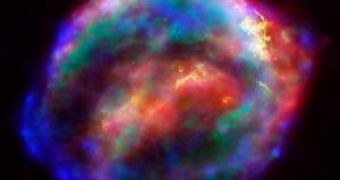80 computers, 320 CPUs of power, 640 Gigabytes of RAM and 96 terabytes of hard disk memory. If that's not music to your years, I don't know what music is. Don't be fooled by the name though, the SUGAR complex will be the new supercomputer complex which will help physicists at the California Institute of Technology to process the massive amounts of information received from the Laser Interferometer Gravitational-Wave Observatory, which has the role of detecting potential gravitational waves produced by black hole mergers or other mass interactions.
Well, the LIGO instrument has done its job well in the last two years, so it's time to see what we've got. SU Gravitational and Relativity Cluster is being assembled by Duncan Brown, assistant professor of physics and member of the SUGAR program, which has also worked previously at the LIGO instrument, administered by Caltech.
Gravitational waves have been predicted to exist by German physicist Albert Einstein in 1916, soon after publishing his Theory of General Relativity, and are thought to be generated during interactions between extremely massive objects such as black holes and neutron stars. The LIGO instrument was completed back in 2005 and has detectors build by several facilities around the world, in cities such as Hanford, Livingston and even countries like France, Germany, Italy and Japan.
For nearly two years, these detectors have been searching for evidence of gravitational wave, but the collected data could not be processed in real time, thus is was stored for future processing. Nonetheless, isolating a specific signal in order to associate it to an event, such as the merging of two black holes, is not as simple as one might think, especially taking into consideration the fact that nobody knows what a black hole actually sounds like. Brown argues that, by using Einstein's equations and the computing power of SUGAR, his team will be able to create models to render gravitational wave produced during the collision of two black holes.
Black holes are extremely difficult to study, because, as their name tells us they are black, they do not emit light in any given spectrum, unless they are accreting matter. Thus optical instruments of any kind are useless for the study of black holes, but one may actually learn more about black holes just by listening to gravitational waves.
Also, the SU Information Technology and Services facility housing the SUGAR supercomputer cluster, will receive a high-speed fiber-optic network which will link the Caltech LIGO instrument and SU's supercomputer, for a better information exchange. It is predicted that SUGAR will go online somewhere in the end of the current month, to test the last remaining untested prediction of Einstein's Theory of Relativity.

 14 DAY TRIAL //
14 DAY TRIAL //